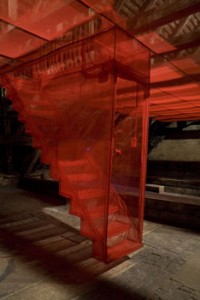« News World
A Question of Evidence, at Thyssen-Bornemisza Art Contemporary (Vienna)

Do Ho Suh. Staircase-V, 2008. Polyester and stainless steel tubes. Dimensions site specific. Thyssen-Bornemisza Art Contemporary. Installation view A Question of Evidence, T-B A21, Vienna 2008. Photo: Ulrich Dertschei / T-B A21, Vienna
November 20, 2008 - April 5, 2009
“A Question of Evidence,” on view at Thyssen-Bornemisza Art Contemporary includes artworks by a selection of artists and cultural practitioners that engage with or comment upon the difficulty of creating, collecting, and disseminating evidence-based source material around issues such as identity politics, the suppression of human rights, democratic reform, and attempts to restrict free expression and representation. As “narrations of urgency,” the pieces in the exhibition often present multiple perspectives on con?icted or rapidly changing realities.
Among the participating artists, we can mention, Amar Kanwar (India), Raqs Media Collective (India), Ritu Sarin & Tenzing Sonam (India/Tibetan in exile), Nikolaus Hirsch & Michel Müller (Germany) in collaboration with Cybermohalla Ensemble (India), Marine Hugonnier (France/UK), Pak Sheung Chuen (Hong Kong), Heman Chong (Singapore), Khin Khin Su (Myanmar), Gonkar Gyatso (Tibetan in exile/UK), Qiu Zhijie (China), Amnye Machen Institute (India). Also on view is the Special Project “Staircase-V,” 2008 by Do Ho Suh (Korea).
Some participants present a side of their practice that is interdisciplinary, collaborative, or hybrid, as in the case of Khin Khin Su, Marine Hugonnier, Raqs Media Collective, and Amar Kanwar. Most of them, in fact, regularly collaborate with grassroots collectives that, faced with restricted channels of communication, manage to conduct research and disseminate information through Internet-based networks, video and ?lm databases, open-source initiatives, and other means.
The exhibition incorporates a variety of artistic and cultural approaches - including moving image, still photography, text, archival material, installation, and theatrical performance-that encompass diverse viewpoints on the nature and function of representation in the face of “real” events and sociopolitical circumstances. The works in the show exemplify the transformation of the concept of visual art to one of visual-intellectual culture or knowledge production. While restricted in its geographical scope - most participants live in South or Central Asia - the exhibition does not overlook, but rather illuminates the essential differences in the role and presence of artists and practitioners within the public realm in their respective contexts.
Further information, www.TBA21.org
Filed Under: News World


































